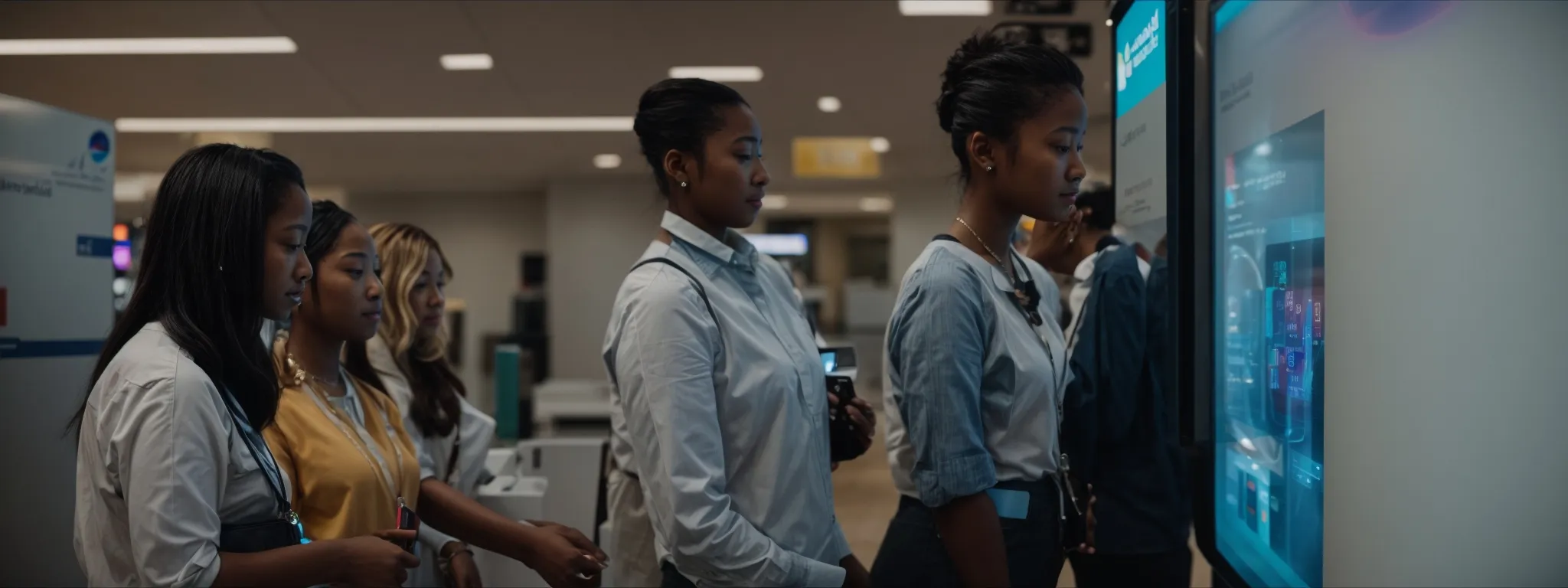Services
Delivering Effective and Efficient Services for the American People In an age where swift and responsive service delivery stands as the cornerstone of public trust, government agencies […]
Delivering Effective and Efficient Services for the American People
In an age where swift and responsive service delivery stands as the cornerstone of public trust, government agencies are embracing novel strategies to elevate their performance.
By streamlining processes and integrating advanced technology, these entities strive to refine the management of services, ensuring they are both accessible and transparent.
Efforts to enhance service delivery resonate across various sectors, manifesting in improved experiences for citizens nationwide.
As investment in continuous service improvement becomes a priority, the promise of more efficient, user-centric government operations turns into a tangible reality.
Keep reading to explore the transformative approaches that are reshaping how services are delivered to the American people.
Key Takeaways
- Service Delivery Challenges Require Identification of Bottlenecks and Strategic Technological Implementation
- Training and Integrating User Feedback Are Essential for Improving the Efficiency and Quality of Service Delivery
- Government and Organizations Are Leveraging Strategic Partnerships and Multilingual Support to Ensure Inclusivity and Accessibility
- Agencies Are Adopting Open-Data Initiatives and Transparent Communication Channels to Foster Public Engagement and Accountability
- Continuous Innovation and Adaptability in Services Are Key to Meeting the Evolving Needs of Society and Maintaining Service Excellence
Streamlining Processes to Enhance Service Delivery

In today’s fast-paced landscape, delivering services that not only meet but exceed expectations stands at the core of organizational success.
Government agencies, health care providers, and companies across sectors confront an ongoing challenge: optimizing their service delivery to align with the evolving demands of citizens, clients, and consumers.
Within this arena, addressing inefficiencies requires a dedicated focus on identifying bottlenecks that impair workflow, the strategic application of technology solutions to streamline operations, a Robust Investment in Staff Training to assure prompt and skilled responses, and the integration of user feedback to continuously polish the quality of service.
When these strategies unite, they form a formidable approach to enhancing service delivery that is responsive, user-centered, and resilient against the tides of change.
Identifying Bottlenecks in Current Service Processes
Understanding the intricate network of service operations is fundamental to pinpointing the precise factors that hamper efficiency. Scrutinizing procedure logs and workflows reveals the critical pressure points: Those moments where tasks languish due to unclear protocols or inadequate resources.
Once illuminated, these bottlenecks provide a blueprint for remediation, guiding agencies and organizations toward targeted improvements. Systemic analysis uncovers patterns of delay, allowing leadership to devise informed, impactful strategies:
| Service Area | Bottleneck Identified | Potential Solution |
|---|---|---|
| Customer Service Response | Delayed Query Resolution | Implementation of an AI-driven support system |
| Document Processing | Inconsistent Approval Times | Restructuring of the approval hierarchy |
| Health Care Claim Submission | Manual Data Entry Errors | Transition to automated data capture technology |
Implementing Technology Solutions for Improved Efficiency
The integration of technology solutions often serves as the cornerstone for Enhancing the Efficiency of Service Delivery processes. By implementing robust software platforms, government organizations, health care entities, and private sector companies enable a transformative shift from manual to digital workflows, thus reducing the likelihood of human error and increasing the speed of service delivery.
Technology solutions such as Mobile Apps and Online Portals grant users immediate access to services and streamline communication channels between agencies and the public. These dynamic tools not only simplify the user experience but also empower service providers to manage and respond to needs with unprecedented agility.
Training Staff for Quick and Competent Service Provision
Empowering staff with advanced training stands as a pivotal investment for any entity keen on refining the caliber of its service provision. With targeted instruction, employees not only gain a deeper understanding of the workflows but also develop the agility to address variegated challenges competently.
Embarking on an educational thrust that instills both confidence and efficiency, professionals harnessed with the right tools are far better equipped to tackle complex processes and deliver services that resonate with efficacy and expediency. Comprehensive training initiatives cultivate a workforce that’s not just quicker on their feet but also represents the organization with unparalleled proficiency.
Integrating User Feedback to Refine Service Delivery
Seamless integration of user feedback is indispensable for refining service delivery, creating a virtuous cycle of improvement and satisfaction. It equips organizations with the first-hand insights needed to identify user pain points, preferences, and expectations directly from the source: the citizens and clients themselves.
By continuously incorporating this valuable feedback, agencies and service providers ensure their offerings evolve in lockstep with the needs of their users. The result is a responsive and adaptive service ecosystem that upholds the ethos of a customer-centric approach:
- Iterative design enhancements based on user experience (UX) evaluations
- Critical assessments of current service offerings against client expectations
- Adjustments to customer service protocols to optimize user satisfaction
Such commitment to involving the end users in the service enhancement process fosters a culture of excellence that remains attuned to meaningful feedback. Consequently, this empowers providers to consistently refine and elevate the standard of their services.
Leveraging Technology for Better Service Management

In an era characterized by rapid technological advancements, government organizations, healthcare entities, and private corporations recognize the imperative to harness innovative solutions for service management.
The quest for greater efficiency and effectiveness has led to the embrace of modern digital strategies, including adopting cloud services for seamless data accessibility, utilizing mobile applications to ensure on-demand service delivery, automating routine tasks to allocate human resources to more complex needs, and fortifying digital platforms against ever-evolving cybersecurity threats.
These initiatives are crucial for maintaining the integrity and reliability of services that millions of Americans rely upon daily.
Adopting Cloud Services for Data Accessibility
Cloud services have become a linchpin for data accessibility, enabling government and healthcare organizations, alongside private companies, to tap into a vast reservoir of information swiftly and securely. This scalable infrastructure supports real-time data analysis and decision-making, ensuring that stakeholders can access the necessary information without the constraints of physical location or device dependence.
With the adoption of cloud-based systems, service providers have witnessed a remarkable transformation in the management of data streams: from increased storage capabilities to heightened collaborative potential among dispersed teams. To facilitate this transition, strategic implementation plans are crafted, sensitive data is meticulously migrated, and Robust Cybersecurity Measures are integrated:
| Phase | Action | Outcome |
|---|---|---|
| Initiation | Strategic Planning and Cloud Service Selection | Framework Established for Seamless Migration |
| Execution | Data Transference and System Integration | Operational Efficiency and Improved Data Accessibility |
| Finishing | Cybersecurity Enhancement and Staff Training | Secure, Reliable Access to Cloud Resources |
Utilizing Mobile Applications for on-the-Go Service
In an environment where immediacy is paramount, the development and deployment of mobile applications have emerged as a cornerstone of service management. Both government entities and healthcare providers are harnessing these applications to facilitate real-time, remote interactions between service agents and users, thereby bolstering accessibility and responsiveness.
Such applications stand as testaments to commitment, enhancing user experience by enabling the American people to obtain services, schedule appointments, and receive notifications while on-the-move. These innovations are not mere conveniences but fundamental shifts towards a service delivery architecture that meets the modern demand for flexibility and efficiency.
Automating Routine Tasks to Free Up Human Resources
The strategic automation of routine tasks stands as a beacon of modernization within service provision. Government agencies and health care providers are turning to this methodology to liberate highly skilled workers from the constraints of mundane responsibilities, thereby elevating their capacity to tackle more complex challenges and enhance the overall quality of service delivery.
By deploying sophisticated algorithms and AI-driven tools, organizations across the nation are not only Accelerating Day-to-Day Operations but also reallocating their human capital toward tasks that necessitate critical thinking and personal interaction. This shift not only optimizes resource management but also fortifies the commitment to delivering services that are not just efficient, but also meaningful and individualized.
Ensuring Cybersecurity in All Digital Services
Ensuring digital security across services is a critical priority for agencies and organizations as they expand their online presence. Robust cybersecurity measures are imperative to safeguard sensitive data against unauthorized access and cyber threats.
Proactive Strategies are essential for the prevention of digital vulnerabilities that could compromise the integrity of the services provided to the American people. The adoption of advanced encryption protocols and continuous monitoring systems constitutes a shield against potential breaches:
| Cybersecurity Initiative | Description | Expected Impact |
|---|---|---|
| Encryption Protocols | Deployment of state-of-the-art encryption methods for data in transit and at rest. | Enhanced protection of user information and reduction of data theft risks. |
| Monitoring Systems | Continuous surveillance of digital platforms for early threat detection. | Immediate response to security incidents, limiting potential service disruption. |
Fostering Transparency in Government Services

Fostering transparency in government services demands an unwavering dedication to accessibility and open communication.
It embodies the ethos of public service by promoting visibility into the internal workings of government processes.
The American people not only desire but also deserve an intimate understanding of how their data is being used, their voices heard, and their resources managed.
In pursuit of this transparency, government organizations are diligently working to implement open-data initiatives that allow for robust public auditing, enhancing communication channels to ensure service users are informed and heard, setting clear service standards to establish tangible accountability, and meticulously Reporting Service Performance against rigid benchmarks.
Such concerted efforts to demystify government operations engender trust and foster a more engaged and informed citizenry.
Implementing Open-Data Initiatives for Public Auditing
Advancing the principles of accountability and transparency, the deployment of open-data initiatives stands as a fundamental pursuit for government agencies intent on fostering public auditing. By making datasets freely available, government entities empower citizens to perform independent evaluations of public spending, policy outcomes, and operational effectiveness.
This commitment to open data not only cultivates a culture of transparency but also drives innovation, as developers and analysts have the opportunity to create tools and services that leverage this wealth of information for the betterment of public service and socio-economic research.
Enhancing Communication Channels With Service Users
Revitalizing Communication Channels constitutes a direct pathway to heightened transparency, enabling a fluid exchange between service providers and users. Initiating open dialogues through various platforms allows agencies to address concerns and dispel ambiguities that could cloud public perception:
| Platform | Objective | Impact |
|---|---|---|
| Social Media | Engage with users in real-time, providing updates and fielding questions | Enhances service relatability and instills a sense of community |
| Feedback Portals | Collect and analyze user feedback for service improvements | Encourages a participatory approach, fostering user-centered adaptations |
| Public Forums | Facilitate discussions for broader understanding of services | Promotes transparency and reinforces democratic engagement |
Engagement protocols are evolving to better capture the voice of the community, ensuring government operations do not merely inform but also actively listen and respond. This shift towards a two-way communication model paves the way for a more democratic, inclusive, and service-oriented government.
Setting Clear Service Standards for Accountability
Establishing Clear Service Standards is paramount to maintaining accountability within government services. These benchmarks delineate the expectations for service quality and efficiency, providing a measurable framework against which government agencies can evaluate their performance and foster public confidence in their operations.
By adhering to transparent service standards, agencies demonstrate a commitment to excellence and a respect for the public trust. This adherence ensures that every citizen interaction with government services is met with consistency, fostering a trusted environment where accountability is not only expected but also systematically delivered.
Reporting Service Performance Against Benchmarks
Reporting service performance against benchmarks is an exercise in accountability that solidifies the bond between government services and the public entrusted to them. As agencies strive for operational transparency, they systematically track performance data and compare outcomes to predefined standards, ensuring that the American people are kept abreast of the effectiveness and efficiency of the services they rely upon.
Engagement with these benchmarks facilitates an objective assessment of service delivery while empowering citizens with the necessary tools to hold government bodies to account. Precise metrics illuminate the successes in meeting service goals and highlight areas in need of amelioration, thus driving continuous improvement across all facets of public service:
| Service Domain | Benchmark | Performance Outcome |
|---|---|---|
| Health Insurance Processing | Application resolution within 30 days | 90% achieved within the target timeframe |
| Veteran Affairs Assistance | Response to inquiries within 48 hours | 85% of inquiries met the benchmark |
| Infrastructure Project Completions | Finishing projects on budget and schedule | 75% completion complying with fiscal and temporal guidelines |
Expanding Access to Services Across Communities

Ensuring the broad reach of vital services to every corner of the nation is a commitment that remains at the forefront of government and organizational efforts.
As these entities endeavor to bridge the gap between service provision and community needs, they engage in a concerted pursuit to identify areas and populations where services may be lacking.
This commitment to service expansion not only encapsulates the essence of equity but also embodies the dedication to bring services directly to the people—whether through innovative mobile units, strategic partnerships with local organizations, or by incorporating multilingual support to respect and respond to the nation’s rich cultural diversity.
Each strategy reflects a deeper understanding of community intricacies and a genuine response to the call for inclusive, accessible, and efficient service delivery for all American citizens.
Identifying Under-Served Areas and Populations
Uncovering areas where services fall short involves a meticulous analysis of regional data and demographic insights. Entities across the board, including government agencies and healthcare providers, are deploying resources to map out and reach communities that historically have had limited access to essential services, ensuring Equitable Distribution of Support and Resources.
By methodically examining factors such as geographic isolation, socio-economic status, and language barriers, these organizations proactively identify populations that may benefit from targeted service enhancements. The strategic identification of these under-served groups allows for the tailored design and delivery of services that bridge the accessibility divide, reinforcing a national commitment to inclusivity and fairness.
Bringing Services to the People With Mobile Units
The Deployment of Mobile Units represents a strategic and innovative approach to ensure that no citizen is left without access to vital services. These roving resources are essential in marshaling healthcare, social services, and governmental assistance directly to the heart of communities, particularly those in remote or underprivileged areas.
Mobile units extend the reach of established service centers, breaking down geographical and logistical barriers. They serve as a cogent example of how service providers demonstrate their commitment to accessibility and underscore their determination to meet citizens where they live, work, and learn.
Partnering With Local Organizations for Service Distribution
A synergy between entities and local organizations magnifies the impact of service provision, effectively narrowing the bridge between governmental offerings and community accessibility. Collaborations with NGOs, nonprofits, and local businesses extend the functional reach of services, ensuring they resonate with localized needs and cultural nuance.
These strategic alliances embody the spirit of tailored service distribution, allowing for a nuanced approach to community engagement. By leveraging the established trust and networks of local organizations, services are delivered with greater precision and relevance, enhancing the wellbeing of citizens across divergent locales.
Offering Multilingual Support to Cater to Diverse Citizens
Embracing America’s rich cultural tapestry, the Provision of Multilingual Support stands as a cornerstone in ensuring that services are comprehensively accessible. Through this initiative, organizations acknowledge the diverse linguistic needs among citizens, creating a welcoming environment that promotes inclusivity and clear communication.
This commitment to linguistic diversity empowers both native speakers and those for whom English is not the first language, effectively removing language barriers to essential services. Catering to a multilingual populace, service providers reinforce the principle that every individual, irrespective of their language, has equitable access to the services they require:
| Service Sector | Linguistic Barrier | Multilingual Support Initiative |
|---|---|---|
| Health Care Services | Non-English Speaking Patients | In-person and Remote Interpreter Services |
| Government Assistance Programs | Complex Bureaucratic Terminology | Translation of Documents and Forms |
| Local Community Outreach | Varied Linguistic Demographics | Cultural Competence Training for Service Staff |
Prioritizing User Experience in Service Provision

In the quest to fulfill the aspirations of the nation, service providers are increasingly turning their gaze inward, recognizing that the heart of effective service delivery lies in the user experience.
This critical pivot towards user-centric designs has sparked initiatives across sectors aimed at syncing services with the nuanced expectations of Americans.
Government entities, healthcare institutions, and private companies alike are now deploying a broad spectrum of strategies, from conducting comprehensive surveys for insights into the public psyche to refining digital interfaces for seamless interaction.
This shift underscores a holistic effort to infuse customer care into the fabric of service provision, ensuring every touchpoint is sculpted to deliver satisfaction, encourage feedback, and drive continuous improvement—a testament to an unwavering allegiance to service excellence.
Conducting Surveys to Understand User Expectations
In the mission to offer user-driven public service, government agencies have incorporated the practice of survey administration to gauge the expectations and satisfaction levels of American citizens. This strategy involves crafting questions that dynamically assess how services align with the public’s needs.
Collected data from these instruments shed light on the public’s perception, guiding bureaucrats and service designers in tweaking and reshaping the service portfolio. These insights lead to meaningful reforms that resonate with user priorities and optimize overall service delivery:
- Adaptation of services based on direct input from service recipients
- Iterative development informed by ongoing user feedback cycles
- Personalization of services to cater to the unique needs of different communities
Redesigning Service Interfaces for Ease of Use
Service interfaces stand as the gateway through which citizens engage with essential offerings. An unwavering focus on redesigning these interfaces places emphasis on simplicity, intuitiveness, and responsive design, ensuring that users of all ages and technical proficiencies can navigate services with ease, fostering equitable access across the diverse tapestry of American life.
Agencies and organizations are marrying aesthetic appeal with functional design in their interface overhaul, allowing for greater clarity and reduced complexity during user interactions. This assertive shift towards user-friendly platforms prioritizes efficiency and effectiveness, reflecting a dedication to removing barriers and enhancing the quality of every service encounter.
Implementing a Feedback Loop for Continuous Improvement
Service providers across the nation are actualizing the concept of continuous improvement by rigorously implementing a feedback loop into their operational frameworks. This vital loop not only captures the voices and concerns of American citizens but also translates them into actionable insights that fuel perpetual service refinement.
Adopting this cyclical approach to user feedback, entities such as government organizations employ cutting-edge tools to analyze responses systematically, enabling them to implement tailored enhancements that directly address user concerns and elevate the service experience.
Training Staff in Customer Care Excellence
In the pursuit of service excellence, training staff in customer care is essential. It equips them with the necessary expertise to interact with service users effectively, ensuring that each encounter reflects the organization’s commitment to quality and respect for the user’s time and needs.
Comprehensive customer care training programs are designed to embody the organization’s values and service principles. These programs impart not only the technical skills required for efficient service delivery but also the soft skills that foster a supportive and empathetic interaction with service users.
- Identify core customer service objectives aligned with the organization’s mission.
- Develop a structured training curriculum that encompasses both hard and soft skill components.
- Implement ongoing evaluation and feedback mechanisms to continuously improve customer care abilities.
Investing in Continuous Improvement of Services

Embarking on a progressive journey of service enhancement, the United States is steadfast in aligning with the dynamic rhythms of its people’s aspirations.
Steered by an unwavering commitment to serve with distinction, there is an ongoing investment in the pillars of research and development, innovation, societal adaptability, and adherence to exemplary standards of excellence.
As the nation strides forward, it continues to refine its offerings, ensuring that every service stands as a beacon of efficient operation, innovative design, and relevance to contemporary civic life—all measured against the world’s gold-standard practices in service delivery.
Allocating Resources for Research and Development
The American spirit of innovation is alive and well within the realm of service delivery, as substantial resources are funneled into research and development (R&D). This investment serves as the lifeblood for pioneering the next generation of services, seamlessly fusing technological advancements with deep insights into the American ethos.
By strategically allocating funds towards R&D, the nation sets the stage for groundbreaking service models that are both progressive and uniquely tailored to the populace’s needs. The resolve to fuel continuous service improvement through diligent research positions the United States as a paragon of service excellence on the global stage.
Encouraging Innovation in Service Solutions
Service Solution Innovation stands as a cornerstone of American progress, driving the transformation of how services are conceived and implemented across various sectors. Entities are actively exploring cutting-edge technologies and novel methodological approaches, striving to ensure that service solutions not only address current needs but are also preemptively designed for future demands.
Federal and local agencies are intensifying collaboration with tech startups and established innovators alike, channeling a collective ingenuity to reshape the service landscape. This concerted effort aims to bring forward-thinking, user-centered services to the American public, reinforcing the commitment to a future where government and private sector services are seamlessly interwoven with the fabric of everyday life.
Updating Services to Reflect Changing Societal Needs
Recognizing the dynamic nature of societal necessities, service providers conscientiously reassess and recalibrate their offerings to ensure alignment with contemporary life. They integrate current trends, demographic shifts, and policy changes into their service models, thus reflecting a deep commitment to the evolving needs of the nation.
Agencies and Organizations Actively Pursue Advancements in technology and methodology to bring their services into the next era of societal development. Their initiatives reveal a readiness to adapt and evolve, thereby sustaining relevance and delivering high-caliber services that echo the pulse of American communities.
Benchmarking Against Best Practices in Service Delivery
Benchmarking Against Best Practices is a fundamental strategy employed by service providers eager to excel in their delivery. This process entails a meticulous evaluation against the highest standards within the industry, ensuring that every aspect of service—from response times and user accessibility to the competence of customer support—is not just meeting but also setting a benchmark for excellence.
Through this rigorous appraisal, agencies and organizations identify gaps in their current strategies and initiate improvements to elevate their service provision to leading levels. This commitment to adopting best practices reflects a dedication to efficiency, quality, and most importantly, the satisfaction of the American public who entrust their needs to these services.
Conclusion
In conclusion, delivering effective and efficient services for the American people is paramount for fostering trust, ensuring satisfaction, and enhancing the overall quality of life.
Embracing technology, streamlining processes, and investing in continuous improvement are critical actions that government agencies, healthcare providers, and private companies must undertake to meet the evolving needs of citizens.
By identifying and addressing bottlenecks, leveraging cloud computing, mobile applications, and robust cybersecurity measures, and acknowledging the importance of user feedback and training, service providers can vastly improve their offerings.
Furthermore, adopting open-data initiatives, emphasizing communication, and expanding service access through mobile units and multilingual support demonstrate a commitment to transparency and inclusivity.
Ultimately, prioritizing the user experience and continuously benchmarking against best practices ensure that services remain relevant, accessible, and of high quality, embodying the American spirit of innovation and progress.















































































